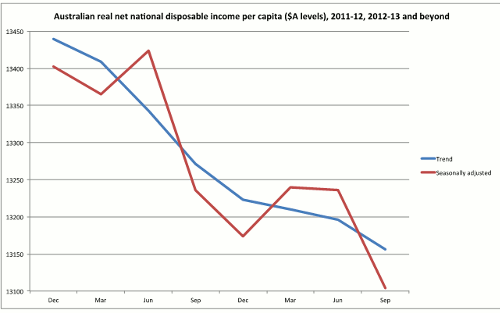Some economists recently warned Australian real incomes will fall. Yesterday's national accounts remind us this has been so for about two years now (see Chart).
Real net national disposable income per capita (trend or seasonally adjusted) has fallen since peaking in the second half of 2011. Real per capita income in the September quarter, 2013, was about 2% lower than in the second half of 2011. Falling terms of trade and slower economic growth have been important causes. More declines in our terms of trade are likely.

Advertisement
Source: ABS, September quarter national accounts.
This economy-wide measure of changes in Australian incomes has been obscured by other indicators. For those with jobs, nominal wages growth has been modest, but still keeping pace with, if not running ahead of, modest inflation, so real wages are flat or increasing. Real consumption is still increasing, and was a significant driver of overall economic growth (albeit less, recently, than net exports).
But increasing living standards (measured by per capita consumption) cannot be sustained unless real per capita income growth returns.
What can we do about this?
We have little influence over our terms of trade. Further declines in future are likely. So we need to offset these before sustainable income gains are possible.
We have two choices. We can (i) increase the application of productive inputs, and/or (ii) increase the productivity of those inputs.
Advertisement
In the first category, dealing with current government-imposed impediments to increased labour force participation is needed.
Much lip service is given to encouraging older Australians able and willing to work to do so. Eliminating current high effective marginal tax rates (at least 50% or more) for those receiving the age pension once the income test applies is a concrete example of action. This 'carrot' is likely to be more palatable than forcing further increases in the retirement age for pension access, though that is needed too as longevity increases and the population ages.
In many cases, increased investment to repair and upgrade Australia's infrastructure is desirable. For example, investment in Australia's grain supply infrastructure seems urgently to be needed. Sometimes, that investment might need to come from foreign investors' savings – if that is permitted. Qantas come to mind here, too.
Discuss in our Forums
See what other readers are saying about this article!
Click here to read & post comments.
16 posts so far.